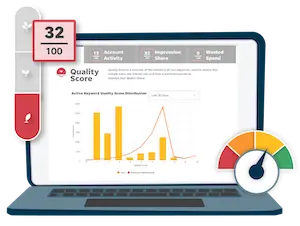
Some of the most popular questions I hear from clients are “What are your recommendations for long-tail keywords?” and “How do I go about finding long-tail keywords?” It seems as though there is some notion leading people to believe there is a magical secret to long-tail keywords. Well, you’re in luck because I am here to tell you that there really is no secret, but rather just a few best practices you should know before beginning your search for long-tails keywords. As you read on, I will dispel some common long-tail keyword myths and point you in the right direction for keyword research and discovery.
Myth #1: The longer tailed the keyword, the better
I sense that the instinctual thought about long-tail keywords is that they need to be fairly long because that’s the only way they are going to work, right? Well no, that’s not necessarily the case. As I often tell my clients, think about how many lazy searchers there are and also think about your own searching habits. More often than not, searchers are probably typing in as few words as they can in order to get results. For example, if I were to take to Google to search for a guide about long-tail keywords, I would probably search for something like “long-tail keywords” or maybe at most “long-tail keywords AdWords.” I certainly am not searching for something like “how do I find and add long-tail keywords to my account in AdWords.” Who even has time for that?
The truth
Longer tail keywords will by nature be less competitive and potentially less expensive, but this often comes hand in hand with a lower volume of searches. Sometimes if the long-tail keyword is too long/too specific you will see the dreaded red text from Google indicating your keyword is a “Low Search Volume” keyword, which means no one is searching for that keyword so Google is deeming it inactive unless search volume increases. This is the worst and just feels discouraging, because you aren’t given the chance to get any traction with the keyword. Even if you’re lucky enough to escape the low search designation, if you’re utilizing keywords that are too long and specific, it will be difficult to draw in a high enough volume of searches for that keyword for you to meet click and conversion goals.
In general you should be trying to capture “longER tail” keywords rather than just general “long-tail” keywords. Sticking to 3-4 terms for these longer tail variations will still allow you to identify some of the more specific/less competitive/less costly keywords without getting to the point where you are using keywords that only one person searches for on a rare occasion. If you fill your account with tons of long-tail keywords that you found because they had one impression and one click in a year’s time, it’s most likely that you will end up with a whole lot of extra keywords that are just hanging around in your account without contributing to any sort of positive performance. And as you may know from a previous blog, I am a strong proponent for clean, organized accounts; so stay away from keywords that are simply going to clutter your account.
Myth #2: I can get away with using only long-tail keywords in my account
This myth is probably more prevalent among users in highly competitive industries that commonly find all of the popular keywords in their industry are too expensive to justify. Especially if you are just starting to build out your AdWords campaign, you have no proof as to whether or not the costly keywords will have any return, so it can be difficult to justify the spend. With that, the tendency is to seek out just long-tail keywords in an attempt to avoid super competitive and expensive keywords.
The truth
Sure, you could probably get away with only using long-tail keywords in your account, but it’s most likely that reaching specific advertising goals will be quite tough. There’s a reason these long-tail keywords are less competitive and there’s a reason why you can’t get away with only focusing on the less popular variations of searches. The reason is simply that there aren’t a lot of people searching for them. If you use only long-tail keywords in your account you will find yourself waiting around for quite some time for an impactful number of impressions.
Myth #3: Long-tail keywords will save me a ton of money and really give me a competitive edge
The quest for long-tail keywords is often sparked by the desire to save money by avoiding the more general keywords (which are often more competitive and thus more expensive). If I were a business owner, I would have the exact same mindset and would also want to adopt this strategy because it makes sense, in theory. To be fair, there is definitely some truth to this myth where long-tail keywords can save some money and give you a competitive edge, but you will largely be saving money simply because those keywords aren’t garnering as many searches and clicks as some of the more generic/popular keywords. It’s pretty simple really: less clicks means less money spent.
The truth
Similar to the world of fad diets, if it was really that easy, don’t you think everyone would be doing it? Like I said, there is some truth to the myth in that you can save and see less competition with long-tail keywords, but it’s important to understand that focusing solely on long-tail keywords is not an immediate solution to meeting all of your advertising goals. You will most likely pay less for these keywords and thus meet some goals as far as cost savings, but if you aren’t seeing as many searches and clicks it can be hard to achieve the same lead and conversion goals as with some of the higher volume keywords.
The Best Way to Approach Long-Tail Keywords
Now that I’ve crushed all that you potentially knew to be true about long-tail keywords, you might be wondering how you should approach them moving forward. Here are a few pieces of advice that might help:
Use a combination of short-tail and long-tail
Search demand decreases somewhat significantly as your keywords take on longer tails. That’s not to say you should avoid either short-tail or long-tail by any means. You’ll want to use a combination of more generic, high-volume keywords with a variety of more specific longer-tail keywords. This will allow you to cast a wider net, but still monitor performance of the more descriptive phrases and determine if those keywords will convert and contribute to positive performance in your account. Using a combination will allow you to better identify searcher intent and see where searchers’ minds are at when looking for specific product or service offerings.
Utilize the search data and associated metrics in your own account
The search data from your own account is going to be the best way to gauge whether or not searchers are typing in searches that are in a longer tail form. As with the example above, if you are using short-tail keywords to help in keyword research, you will be able to get a better sense as to volume of specific queries and identify whether or not there is are enough impressions, clicks, etc. from the particular search in order to justify adding it as a keyword to your account. For example, if you are looking at your search queries based on impressions, you might be able to spot some popular searches that have generated clicks and even conversions, but that you aren’t currently utilizing as keywords.
Pay attention to match types on longer tails
It’s perfectly easy to sabotage your own long-tail keyword efforts by getting too restrictive with match types. If you notice that a long-tail keyword isn’t driving any sort of performance, check the match type to see if you are requiring too much of your potential searchers. For example, if you are using an exact match version of a keyword such as [improve my account with long-tail keywords] you are insisting that your searcher enter that into the query bar and nothing else. That’s pretty demanding and unrealistic to think a large number of searchers are going to search for exactly that. Moving down the totem pole of match types at least starts to give you a bit more flexibility, so maybe a phrase or broad keyword might be a better approach.
Don’t immediately give up on a poor performing long-tail keyword
It can be easy to get frustrated with some of the more specific keywords in your account if they aren’t up to par with performance standards, but before you mass delete all low search volume keywords at least consider if you think that a particular keyword has potential. If you do think that a keyword could be worthwhile, investigate some other factors such as a too restrictive match type, broad/generic keywords with higher bids that are monopolizing searches, etc. Sometimes a keyword just needs a bit of a pick-me-up by raising the bid, adjusting match type, or simply rewording the keyword slightly.
Ultimately the not so secret “secret” to long-tail keywords is to use your knowledge of how people typically search for your business, take advantage of what the data in your account is telling you, and test a few strategies to figure out what works best for your account.










